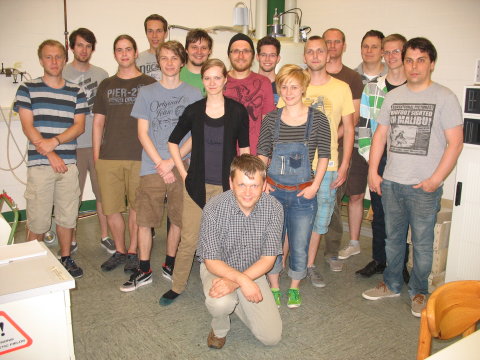Report to the 14. DMG Shortcourse "Applications of Solid State NMR Spectroscopy in the mineralogical and geoscientific research "
in Bochum from 10. June – 13. June 2014

Like every year towards the beginning of the summer, the short course “Application of Solid State NMR Spectroscopy in the Mineralogical and Geoscientific Research” took place at the Institute of Geology, Mineralogy and Geophysics at the Ruhr-University Bochum (RUB) from 10th – 13th June 2014.
Promoted by the Deutsche Mineralogische Gesellschaft (DMG) together with the Deutsche Gesellschaft für Kristallographie (DGK), the short course was headed by Dr. Fechtelkord, Lecturer for Crystallography and Mineralogy at the RUB. Through lectures, practicals and laboratory sessions, Dr. Fechtelkord gave a comprehensive introduction to the fundamentals of NMR spectroscopy, whereby the focus primarily lay on its application regarding mineralogical and geoscientific questions.
Owing to its high popularity across Germany of this short course for master and/or PhD students in geosciences or related disciplines, the course took place for the 14th time and attracted 15 participants from different universities (Oldenburg, Berlin, Hannover, Münster, Mainz, Erlangen and Wien) as well as local students from the RUB. The participants consisted of students, graduates and PhD students of geosciences with varying specialization on mineralogy, petrology and crystallography.
Due to the strong storm on the night before the first day of the short course, the entire public transport system was limited in the region of North Rhine-Westphalia. It took thus up to early in the afternoon until the crew of enthusiastic geoscientists was fully assembled at the RUB.
Each course day started with a theoretical lecture, followed by NMR experiments in the afternoon, where the group operated under the instruction and supervision of Dr. Fechtelkord with the NMR spectrometer (Bruker ASX 400). The spectra analysis from the experiments completed the day. Within this framework of experimental implementation combined with the subsequent spectra evaluation and on the basis of the theoretical expertise, it was possible to give each participant with different prior knowledge an introduction to the routine NMR techniques, as well as the latest developments in this method.
The first day started with several theoretical basics of the NMR spectroscopy including an overview of the technical construction and physical basics of NMR, such as the interactions of atomic nuclei with gyromagnetic moment within the external magnetic field. After a refreshing coffee break, a detailed introduction was given into the principles of the 1H spin lattice relaxation followed by measurements of the spin-lattice relaxation time constants of tetramethylammonium iodide at different temperatures. The measuring results allowed the calculation of the activation energies of the methyl groups from tetramethylammonium iodide. Later, the traditional icebreaker party took place at the “Summa Cum Laude”, which was one of the social highlights.
In the morning of the second day, a deepening theoretical lecture included the chemical shift, the “magic angle spinning” (MAS) process as well as the magnetic dipolar interaction, whereas the software DMNT 2010 was used in the afternoon in order to give an introduction into the spectra analysis. As an exercise on the NMR spectrometer, the group recorded data on minerals containing 29Si, 19F and 1H. These data were also analyzed with DMNT 2010. Later on, another special social highlight followed in the restaurant “VuKo’s”: the entire group played skittles in a nice bourgeois atmosphere and ate hearty meals from the menu.
In the morning of Thursday, the theoretical aspects of the Hahnsches echo and certain multi-pulse techniques e.g., the cross polarization technique (CPMAS) and its application to a kaolinite sample (implying calculations of the H-Si-distances) were the main focus of the day. After a long afternoon interpreting the data from this day experiment, some participants used the common evening to watch the World Cup's opening ceremony in Brazil in the pub district of the city so-called “Bermuda Dreieck (Triangle)”.
The last workshop day was dedicated to quadrupolar nuclei. In this context, the most recent methodical developments in solid state NMR spectroscopy, such as double rotation (DOR) and multi-quantum magic-angle spinning (MQMAS) and satellite transition spectroscopy (SATRAS), were also presented. The short course ended with a briefly positive discussion, before the participants travelled home.
We thank Dr. Fechtelkord for his methodical, academical and didactical commitment.
Katharina Klang (Münster), Dominik Zimmer (Mainz) and Christopher Neun (Mainz)


